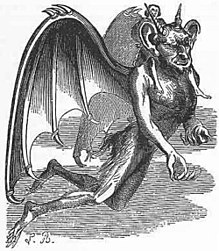Gaap
 From Wikipedia - Reading time: 6 min
From Wikipedia - Reading time: 6 min

Gaap (also Tap, Coap, Taob or Goap) is a demon that is described in demonological grimoires such as the Lesser Key of Solomon,[1] Johann Weyer's Pseudomonarchia Daemonum,[2] and the Munich Manual of Demonic Magic,[3][4][5] as well as Jacques Collin de Plancy's Dictionnaire Infernal,[6]
Demon
[edit]These works describe Gaap as a prince in human form who incites love. The Munich Manual also says that "Taob" also provides medical care for women, transforms them to make it easier to get to a lover, renders them infertile, and rules twenty-five legions of spirits. The other sources instead describe Gaap as a president, giving him the power to teach philosophy and liberal arts, make others invisible, steal familiars from other magicians, make men stupid, and carry men between kingdoms; in addition to ruling sixty-six legions of demons. Johann Weyer also connects Gaap to necromancers, and states that he was first called upon by Noah's son Ham, along with Beleth. He was of the order of potestates.
Gaap (or Goap) is also one of the four cardinal spirits, of the south in the Lesser Key of Solomon, the west in the Pseudomonarchia Daemonum.
In the Livre des Esperitz,[7] Gaap (as Caap) is still a prince, but appears as a knight, brings gold and silver anywhere, and rules twenty legions of spirits.
Accomplished occultist Carroll "Poke" Runyon treats Gaap and Coap as different entities,[8] although they were historically the same figure.[7]
According to Thomas Rudd, Gaap is opposed by the Shem HaMephorash angel Ieuiah.[9]
Modern depictions
[edit]- Gaap is depicted in the visual novel Umineko When They Cry as a female demon who serves the witch Beatrice. She has the ability to teleport herself and others.
- Gaap is played by Paapa Essiedu in the 2023 "Demon 79" episode of Black Mirror.
See also
[edit]- Amaymon – the cardinal spirit of the east in The Lesser Key of Solomon
- Corson (demon) – the cardinal spirit of the west in The Lesser Key of Solomon
- Ziminiar – the cardinal spirit of the north in The Lesser Key of Solomon
References
[edit]- ^ Lemegeton Clavicula Salomonis: The Lesser Key of Solomon, Detailing the Ceremonial Art of Commanding Spirits Both Good and Evil; ed. Joseph H. Peterson; Weiser Books, Maine; 2001. p.18-22
- ^ Pseudomonarchia Daemonum (Liber officiorum spirituum); Johann Weyer, ed. Joseph Peterson; 2000. Available online at Esoteric Archives par 30-39
- ^ Forbidden Rites: A Necromancer's Manual of the Fifteenth Century; Richard Kieckhefer; Pennsylvania State University Press, University Park, PA; 1997. P. 165-167 and 291-293
- ^ The Goetia of Dr Rudd; Thomas Rudd, Ed. Stephen Skinner & David Rankine; 2007, Golden Hoard Press. p.34
- ^ Introduction by Joseph Peterson to Pseudomonarchia Daemonum (Liber officiorum spirituum); Johann Weyer, ed. Joseph Peterson; 2000. Available online at Esoteric Archives
- ^ Dictionnaire infernal: ou Répertoire universel des êtres, des personnages, Jacques Collin de Plancy, 1853, available on Google Books. p.460-469
- ^ a b "Les who's who démonologiques de la Renaissance et leurs ancêtres médiévaux" by Jean-Patrice Boudet, Médiévales 44, Spring 2003, (online link). pars. 25, 28, 56
- ^ The Book of Solomon's Magick by Carroll Runyon, C.H.S. Inc, 1996, p.160
- ^ Rudd, ed. Skinner & Rankine, p.366-376
 KSF
KSF